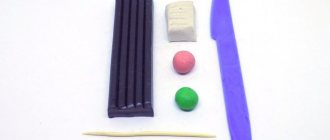Mosaic of balls
A similar technique for children's plasticineography is available to most children. When the child learns to independently roll small spheres from the material, offer him the task of filling the pre-drawn outline with these multi-colored lumps, without pressing the plasticine too much to the surface. This activity perfectly develops imagination and fine motor skills. When performing the exercise, you will be able to color the most fantastic drawing, giving it volume.
Any errors in the work can be easily corrected - you just need to move the colored ball to the right place.
What you need to have
It is advisable to select plasticine that is pliable and soft enough so that the child can change the shape of the element without effort. A wax or other safe mass will do. There is no need to look for multi-colored products - the main thing is that the shades mix well and are bright. Be sure to buy white and black materials to demonstrate to your little one how the transformation of color saturation occurs.
At the first stages of classes, you need to prepare for work:
- rolling board;
- images printed on cardboard or plastic;
- sticks, molds;
- decorations to give the drawing a festive look;
- pastry syringe (it’s easy to squeeze out sausages);
- wide tape (useful for gluing a drawing before work, so that it becomes convenient to quickly correct mistakes);
- wet wipes to wipe plasticine-stained hands.
What kind of plasticine is suitable for plasticineography?
Plasticine, as you know, can be different. One is too hard, the other, on the contrary, is soft, and also leaves greasy marks. The third one is terribly sticky to your hands. It turns out that not every plasticine that is suitable for modeling is suitable for plasticine printing. So which one should you choose for painting?
Classic plasticine is good for everyone: bright, inexpensive, does not stain your hands, does not leave greasy stains, but is very hard and does not apply well to the base. But its wax analogue has good adhesion to the base, is soft, comes in a rich color palette, does not crumble and is ideal for painting with plasticine.
The benefits of drawing with plasticine
Children intuitively try to diversify their daily activities, since they need to learn a lot, learn almost everything on their own.
This is useful for all-round development. Replacing learning activities with creative experiments allows you to improve cognitive skills, awaken the ability to dream, imagine, and think outside the box. Drawing is an accessible and most favorite type of activity for children of any age. The means of fine art have no restrictions: you can use pencils, sand, plasticine, or just your finger, moving it along the frosted glass. The process actively develops fine motor skills in children. When using a brush, the hand learns to hold a pen for writing; working with sand allows you to enhance tactile sensations, incredibly calming the baby. Modeling with plasticine strengthens the fingers, encourages accuracy, giving scope for creative imagination.
Varieties of plasticineography techniques with photos
Just as science does not stand still, technology keeps up with the times. Something is changing, becoming a thing of the past. Something appears, for example: new types of plasticine, work methods, methods and techniques for applying materials, tools, etc. That is, everything that allows you to emphasize the peculiarity, beauty, and individuality of the drawing.
Plasticineography made on any horizontal surface is considered straight. The one that is a mirror image of the picture (usually stained glass) is reverse.
Today the most popular are several types:
Simple plasticineography
Multilayer plasticineography
Stained glass plasticineography
Modular plasticineography
Textured plasticineography
Mosaic technique
Relief (contour) plasticineography
Scratch
Templates for plasticineography
Templates are selected depending on the age of the students. If for children preference is given to simple forms, then for older children images with a large number of small elements are more suitable.
As templates for plasticine painting, you can use coloring books, which are sold in many stores. And for the stained glass technique of creating sketches - any pictures you like. If you don’t want to buy ready-made coloring pages, you can print or draw the silhouette for free here.
A lot can be said about the benefits of plasticineography classes and its impact on the development of a child’s mental abilities. The main thing is that the creative process itself arouses genuine interest, inspires and brings pleasure. This is the only way to form a holistic, comprehensively developed personality, capable of living in harmony with the world around him.
Sausages with spirals
Preschoolers can already make simple plasticine compositions. To do this, you need to roll the material into thin rods. This requires maximum patience, attentiveness and accuracy - such character qualities are developed by such activities. By combining multi-colored stripes, children depict cosmic pictures with stars, a winter forest, the underwater world, and autumn trees. You can make beautiful canvases if you place three-dimensional drawings.
A more complex form of creativity is the rolling of plasticine flagella into a spiral reminiscent of flowers. Using such blanks, you can put together a chic bouquet, depict a fluffy dog or a curly birch tree.
The palette in such drawings will be much richer, the work will be much more beautiful when plasticine of similar shades is rolled together, but without achieving color uniformity. To obtain a festive candy, you will need to carefully twist a pair of thin bright flagella (obtained by squeezing out of a syringe). Then they need to be rolled into a spiral.
Planar modeling
You should start introducing your child to plasticineography by learning the skills of drawing with longitudinal strokes. Show your child how to rub several multi-colored slices of crushed plasticine over the surface. Then start “coloring” geometric shapes in the form of the sun, a large flower, a pyramidal poplar, and animals. Children often use only their index finger when working, but try to get them to use both limbs. Such exercises will help improve the synchronization of the brain hemispheres.
Operating rules
Learning the plasticineography technique occurs quickly. Children simply need to tear small pieces of the desired color from a piece of material, and then make small balls out of them. These elements need to be glued to a sheet of paper with an image drawn on it in the right place. After placing the next part of the picture on the surface, lightly press it with your finger. This procedure is convenient because it allows you to correct mistakes without any extra effort.
When a child creates a plasticine image on a canvas, it is necessary to follow this procedure. In your work, use only bright material that can be easily given the required shape. This will make it easier for pens that are not yet too strong to create exclusive drawings.
To consolidate the acquired skills, separate the stages of training: first show how to press on the material, then practice smearing it. Then combine both methods in the game.
Drawing with scratches and dents
This technique can be used even by three-year-old children. First, any surface must be covered with a layer of plasticine. Then hand the child a thin wooden stick and invite him to use it to draw any patterns on the material. For older children, such a tool will help to detail the finished image, giving it realism by creating additional volume.
Fine scratches are made by fluffy spruce paws and the luxurious tail of a red fox. With a sharp stick, it’s easy to draw thin scales covering the body of multi-colored fish. Children can use special molds to squeeze out finished figures on a smeared layer of plasticine. Preschoolers love to create amazing ornaments in a similar way. To do this, instead of solid silhouettes, small stamps are used, which can be pasta and decorative buttons. A tool that has a hemisphere at the tip is convenient for making indentations in the locations of the eyes of fairy-tale characters or animals.
The technique of drawing with plasticine is a great option for creative games with kids. Using this technique, children are able to create original greeting cards for parents, New Year’s crafts, and competition tasks. There are extremely many different techniques and little tricks in making plasticine canvases; there is huge scope for the imagination of the young artist.





